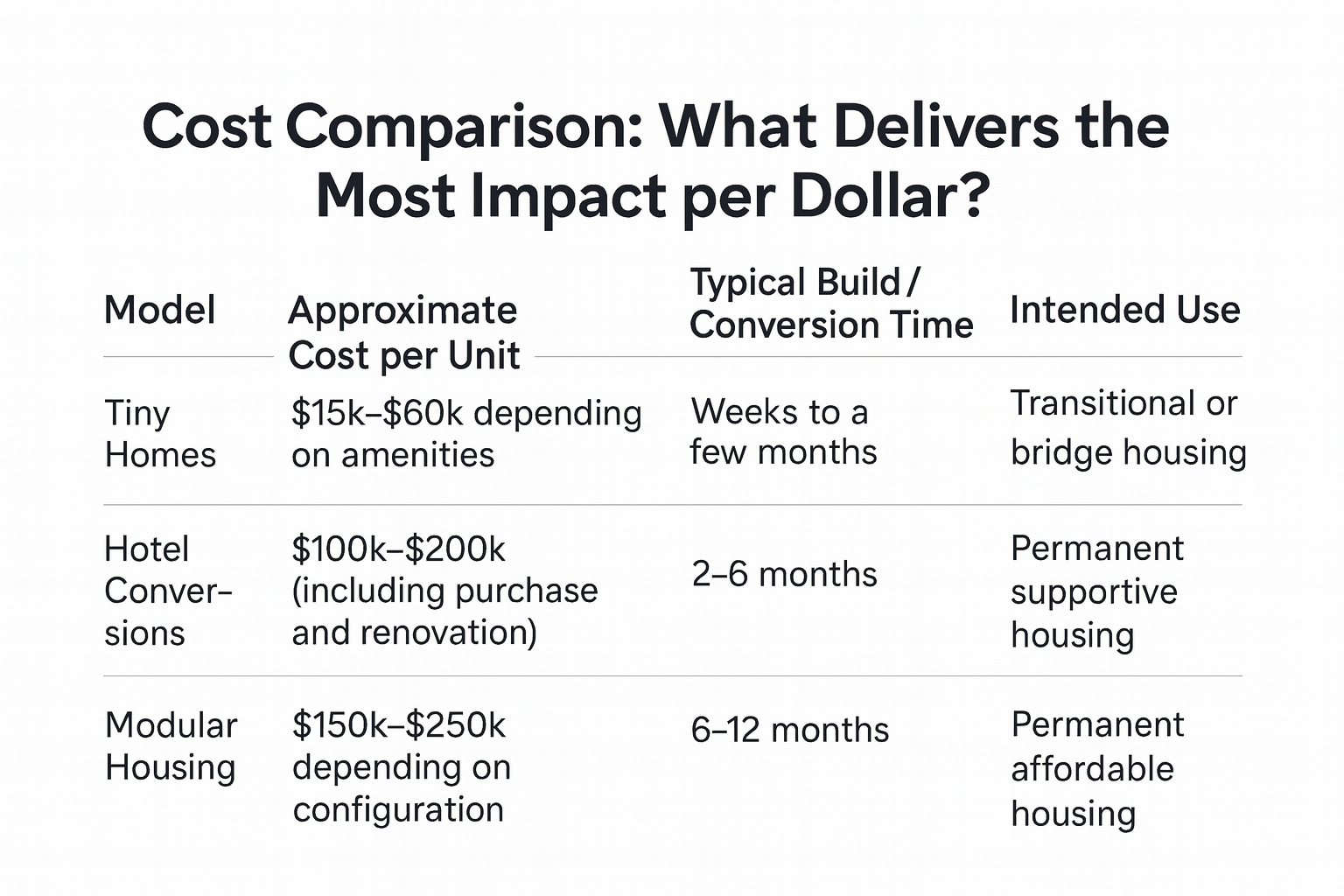America is in the middle of a housing emergency. According to HUD’s 2023 Annual Homeless Assessment Report more than 650,000 people are experiencing homelessness on any given night. Millions more live one paycheck away from losing housing altogether. Traditional development models cannot build fast enough to keep pace with need. Cities and nonprofits have been forced to explore faster alternatives. The three most widely adopted solutions are tiny homes, hotel conversions, and modular housing. Each offers unique strengths depending on the population served. The real question is not which model is “best” but how each one can be strategically deployed as part of a layered housing system.
Tiny Homes for Homelessness: Fast Stability and Community Support
Tiny home villages have emerged as one of the most popular interim housing models. Organizations such as Pallet Shelter and Community First Village in Austin have proven that people are far more likely to accept housing when it offers privacy dignity and autonomy. Unlike congregate shelters tiny homes provide locking doors individual climate control and a small personal space people can call their own. Most villages operate with shared kitchens bathrooms and laundry facilities along with supportive services.
Who tiny homes work best for:
- People exiting encampments
- Veterans and seniors who prefer independence
- Individuals who avoid shelters because of trauma or safety concerns
The Current State of Homelessness in Chicago blog on Cherry Willow Apparel cites that many unhoused individuals refuse traditional shelters not because of a lack of services but because of fear. Tiny homes solve that immediate barrier. They create stability quickly and allow outreach teams to build trust.
Challenges with tiny homes: They are often classified as temporary structures which limits long term zoning approvals. Without exit pathways into permanent housing tiny home communities risk becoming stagnation points. They also require continuous operational funding. They are not a one time capital project. They are a program that must be staffed maintained and integrated into a broader housing system.
Hotel Conversions: The Fastest Path to Private Permanent Units
While tiny homes offer immediate stabilization hotel conversions offer immediate permanence. During the pandemic states like California launched Project Homekey to purchase distressed motels and repurpose them as housing. The benefits were undeniable. Hotels already include electricity plumbing fire safety systems and private bathrooms. Converting them is significantly faster than building from scratch.
Who hotel conversions work best for:
- Seniors and people with disabilities
- Individuals able to live independently with light support
- People transitioning from hospitals or treatment programs
A study by Harvard Joint Center for Housing Studies found that hotel conversions often cost less per unit than new construction while delivering finished housing within months. Unlike large shelter facilities hotel conversions allow residents to live with privacy and dignity immediately.
Challenges with hotel conversions: They require substantial capital upfront especially in high value real estate markets. Without on site support services residents may feel isolated. They work best when paired with nearby case management healthcare or peer support programs.
Modular Housing: Scalable and Flexible Long Term Infrastructure
Modular housing solutions include prefabricated apartments container based structures and panel assembled complexes. These units are built in factories then transported and assembled on site. Cities such as Los Angeles and Seattle have adopted modular housing to cut construction timelines nearly in half while still meeting building code standards for permanent housing.
Who modular housing works best for:
- Families needing full kitchens and multi room layouts
- Youth aging out of foster care who require independent apartments
- Residents transitioning from supportive housing into long term stability
Because modular units can be stacked or clustered they allow cities to build density without long construction delays. Organizations like Harbinger have demonstrated that modular units can be deployed quickly when land and permits are available.
Challenges with modular housing: The primary issue is not the housing technology. It is the system around it. Zoning restrictions community resistance and land use battles often delay modular housing before it is even delivered. The units themselves are fast. The bureaucracy is slow.
Cost Comparison: What Delivers the Most Impact per Dollar?

Tiny homes win on speed. Hotel conversions win on immediate habitability. Modular housing wins on long term resilience. No single model delivers everything.
The Real Answer: Stack Solutions Not Compete With Them
The cities making real progress such as Houston Austin and parts of Washington State are not waiting for one magic fix. They deploy multiple strategies simultaneously. Tiny homes serve as triage. Hotel conversions become rapid housing placement. Modular housing builds permanent community infrastructure.
The Cherry Willow Apparel mission is rooted in that same philosophy. Housing is not charity. It is infrastructure. Every product purchased on the Shop Page fuels partnerships that support innovative housing solutions across the country. When governments stall people can still participate in direct impact. Whether through advocating for zoning reform supporting local housing projects or funding transitional programs change does not require permission.
What You Can Do Right Now
If you want to learn more about the scale of need start with the Mission Page. If you want to move from awareness to action explore Cherry Willow Apparel’s collection. Wearing advocacy is more than symbolic. It funds real services real housing projects and real solutions.
Housing is solvable. The tools exist. The only unacceptable option is waiting.



.jpg)
.jpg)